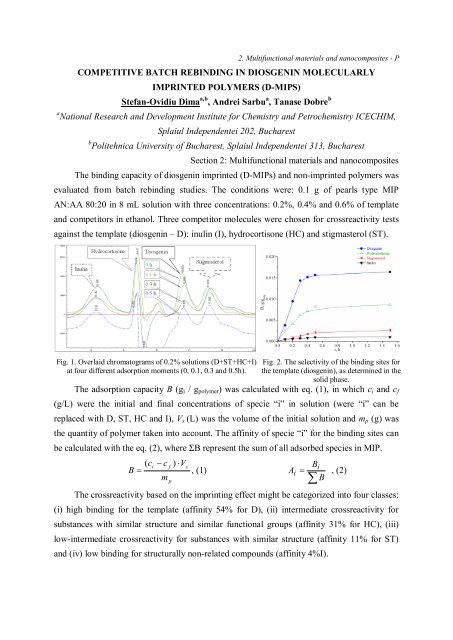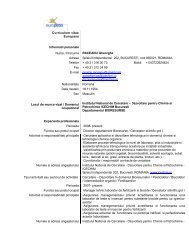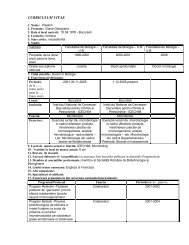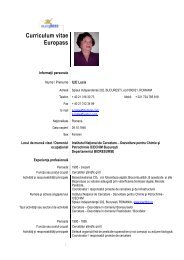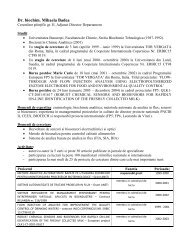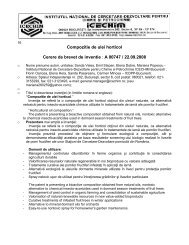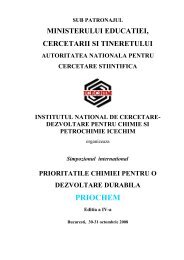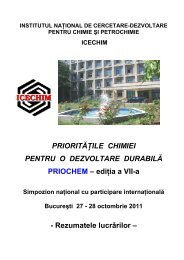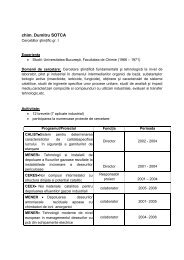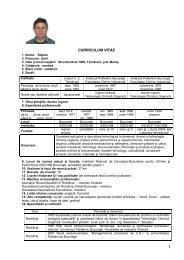2. Multifunctional materials and nanocomposites - PMULTI-COLOURED AQUEOUS PIGMENTS INK FOR DIGITAL TEXTILEPRINTING*ATHANASIU Angela Anca, <strong>DE</strong>ACONU Marian, IONITA Elena, OPROIU LotiCornelia,ALIFANTI Constantin, FILIPESCU Cătalin, POPESCU Alina***,CHIRIAC Laura *** , CRACIUN Constantin ***INC-D pentru Chimie si Petrochimie-<strong>ICECHIM</strong> Bucuresti ( DT C P)*** INC-D Textile –Pielarie Bucuresti;** Universitatea Babes Bolyai-Centrul de Microscopie Electronica- Cluj Napoca,Digital textile printing is based on four components: ink, the printer, the print head andsoftware. For a proper color resistant and print performance is essential is ink that causes thefabric characteristics: color, strength, cough and toxicological impact.The objective was to obtain a range of inks for inkjet printing and their application to textilematerials. To achieve this goal, coloring matters must be micro / nanodispersion and theoptimum particle size to be between 20 nm and 200 nm.Ink jet printing is a process without impact, where ink droplets are produced and deposited ona substrate such as paper, transparent film or fabric, in response to an electronic pulse. Typicalsystems inkjet printing are either continuous wave ink or like "drop on demand".In the inkjet inks, pigments have been used recently or as substitutes dyes, either alone or incombination with them. Pigments shows superior properties compared to dyes, in areas suchas water resistance and light image density, thermal stability, chemical and oxidation dyes andcompatibility with other media compatible with both treated and untreated with. In addition,the pigments are generally non-mutagenicThe biggest problem regarding the use of pigments is micro / nanodispersion and stabilizationof particles in liquid medium. Powder pigment particles are generally very hard and in a stateof congestion. For preparation of inks for inkjet printing, pigment must to be nanodispersedand stabilized in this form, because the level of dispersion characteristics directly affect thefinal print.Highlighting and morpho-structural characterization of microencapsulated liposomeswith organic pigments was done by 3 methods of highlighting, respectively) transmissionelectron microscopy (TEM) with digital image pickup device, b) microscopy video cameraand direct learning opportunity in phase contrast, darkfield, DIC and fluorescence.Nanodispersion inks were obtained by two methods: preparative methods for obtainingliposomal-based inks by microdispersion and nanodispersion organic pigments andsubsequent functionalization processes through the synthesis of organic pigments [surfacewas modified pigments bloom attaching organic groups] followed by pigmental micro /nanodispersion.
2. Multifunctional materials and nanocomposites - PCOMPETITIVE BATCH REBINDING IN DIOSGENIN MOLECULARLYIMPRINTED POLYMERS (D-MIPS)Stefan-Ovidiu Dima a,b , Andrei Sarbu a , Tanase Dobre ba National Research and Development Institute for Chemistry and Petrochemistry <strong>ICECHIM</strong>,Splaiul Independentei 202, Bucharestb Politehnica University of Bucharest, Splaiul Independentei 313, BucharestSection 2: Multifunctional materials and nanocompositesThe binding capacity of diosgenin imprinted (D-MIPs) and non-imprinted polymers wasevaluated from batch rebinding studies. The conditions were: 0.1 g of pearls type MIPAN:AA 80:20 in 8 mL solution with three concentrations: 0.2%, 0.4% and 0.6% of templateand competitors in ethanol. Three competitor molecules were chosen for crossreactivity testsagainst the template (diosgenin – D): inulin (I), hydrocortisone (HC) and stigmasterol (ST).Fig. 1. Overlaid chromatograms of 0.2% solutions (D+ST+HC+I)at four different adsorption moments (0, 0.1, 0.3 and 0.5h).Fig. 2. The selectivity of the binding sites forthe template (diosgenin), as determined in thesolid phase.The adsorption capacity B (g i / g polymer ) was calculated with eq. (1), in which c i and c f(g/L) were the initial and final concentrations of specie “i” in solution (were “i” can bereplaced with D, ST, HC and I), V s (L) was the volume of the initial solution and m p (g) wasthe quantity of polymer taken into account. The affinity of specie “i” for the binding sites canbe calculated with the eq. (2), where ΣB represent the sum of all adsorbed species in MIP.( ci- cfB =mp) × Vs, (1)BiAi = , (2)BThe crossreactivity based on the imprinting effect might be categorized into four classes:(i) high binding for the template (affinity 54% for D), (ii) intermediate crossreactivity forsubstances with similar structure and similar functional groups (affinity 31% for HC), (iii)low-intermediate crossreactivity for substances with similar structure (affinity 11% for ST)and (iv) low binding for structurally non-related compounds (affinity 4%I).å


